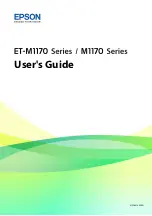
PANDUIT TDP4*H
GMTDPH-MAN
Page 6-7
Section 6: Interface Specifications
READY/BUSY FLOW CONTROL
Ready/Busy is the hardware flow control method for the serial interface on the TDP4*H series printers.
By raising/lowering the voltage level on Pin 20 of the RS232C port, the printer notifies the host when it is
ready to receive data. Pin 4 (RTS) and pin 20 (DTR) are the important signals on the printer for this
method of flow control. The host must be capable of supporting this flow control method for it to function
properly.
X-ON/X-OFF FLOW CONTROL
X-On/X-Off flow control is used whenever hardware (Ready/Busy) flow control is not available or
desirable. Instead of a voltage going high/low at pin 20, control characters representing ìPrinter Readyî
(X-On =11 hexadecimal) or “Printer Busy” (X-Off = 13 hexadecimal) are transmitted by the printer on pin
2 (Transmit Data) to the host. In order for this method of flow control to function correctly, the host must
be capable of supporting it. X-On/X-Off operates in a manner similar to the function of pin 20 (DTR) as
previously explained. When the printer is first powered on it sends an X-Off when the “Buffer Near Full”
level is reached and a X-On when the data level of the buffer drops below the “Buffer Available” mark.
When the printer is taken off-line manually, it transmits an X-Off indicating it cannot accept data. When it
is placed back on line manually, it sends an X-On, indicating it is again available for receipt of data. If an
error occurs during printing (paper out, ribbon out), the printer sends an X-Off as soon as an error
condition is detected. When the error is cleared and the printer is placed back on-line, it transmits an X
On indicating it is again ready to accept data. Upon power up if no error conditions are present, the
printer will continually send X-On characters at five millisecond intervals until it receives a transmission
from the host.
DATA STREAMS
The data streams for X-On/X-Off and Ready/Busy flow control are constructed in the same way as they
are for Ready/Busy flow control.
<ESC>A . . Job#1 . . <ESC>Z<ESC>A . . Job#n . . <ESC>Z
Example: <ESC>A . . Job#1 . . <ESC>Z
NOTE: All characters are in ASCII.
CABLE REQUIREMENTS
DB9
DB25 HOST
INTERCONNECTION
DB25
PRINTER
1
1
FG
1
FG
(Frame Ground)
TD
(Transmit Date)
RD
(Receive Data)
RTS (Request to Send)
CTS (Clear to Send)
DSR (Data Set Ready)
DTR (Data Terminal Ready)
SG
*(Signal Ground)
2
3
RD
2
3
2
TD
3
8
5
CTS
4
7
4
RTS
5
4
20
DTR
6
6
6
DSR*
20
5
7
SG
7
* This connection at the host side of the interface would depend upon the pin that is being used as the Ready/Busy signal by the driving
software. Typically, on a PC, it would be either CTS (pin 5) or DSR (pin 6) on a DB-25 connector.
Summary of Contents for TDP43H
Page 1: ...TDP42H TDP43H TDP46H Thermal Transfer Printer OPERATOR MANUAL GMTDPH MAN...
Page 12: ...PANDUIT TDP4 H GMTDPH MAN Page 1 8 Section 1 Overview Notes...
Page 26: ...PANDUIT TDP4 H GMTDPH MAN Page 2 14 Section 2 Installation Notes...
Page 60: ...PANDUIT TDP4 H GMTDPH MAN Page 4 6 Section 4 Cleaning and Maintenance Notes...
Page 66: ...PANDUIT TDP4 H GMTDPH MAN Page 5 6 Section 5 Troubleshooting Notes...
Page 83: ......
Page 84: ......












































